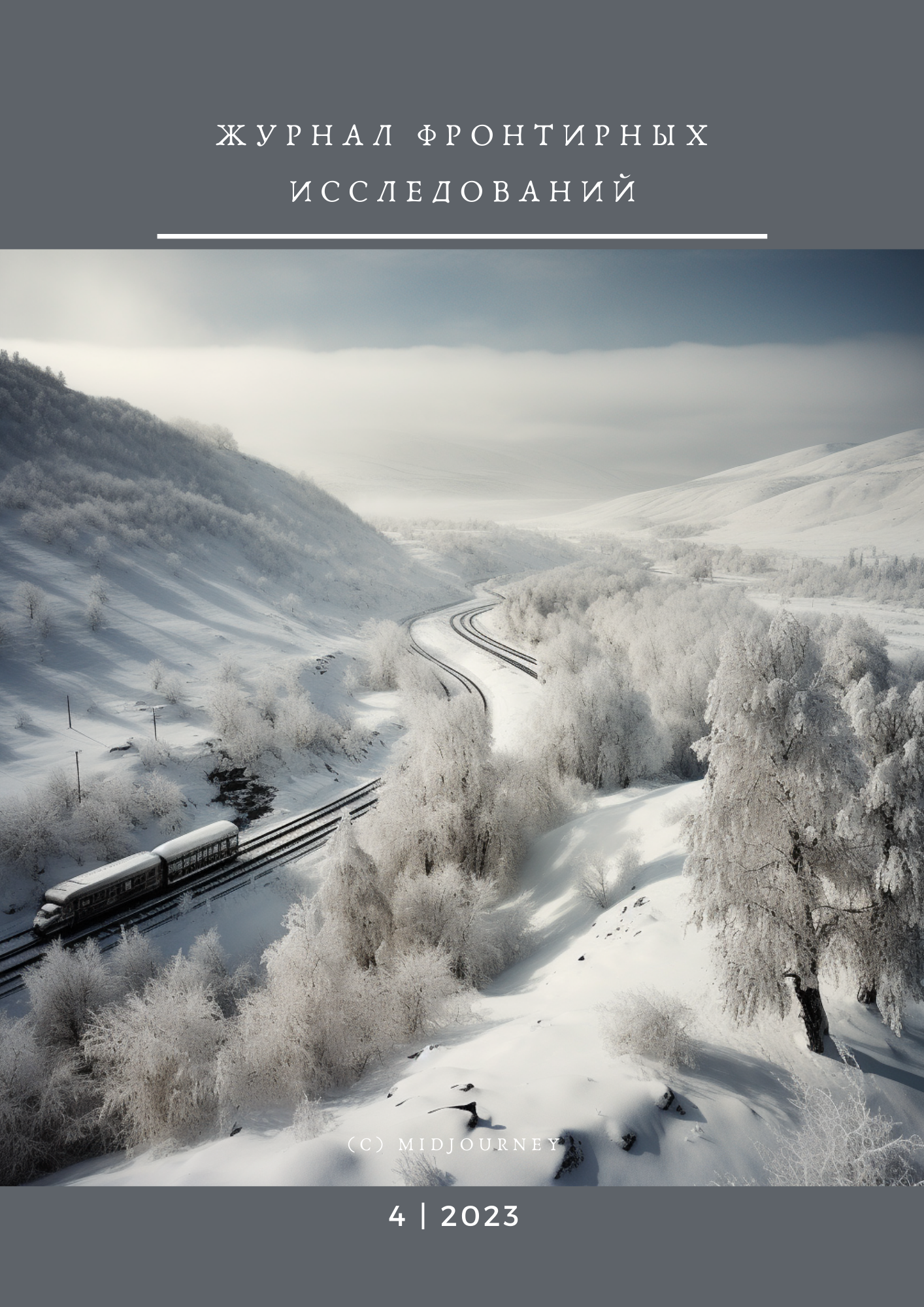Abstract
The article examines and analyzes the portrayal of Austro-Hungary by correspondents of the Russian daily newspaper, “Russian Invalid,” during 1914–1915. This was a period when the Russian Empire was actively engaged in military conflict with the states of the Triple (and later, Quadruple) Alliance on the European front, with Austro-Hungary emerging as one of its primary adversaries on the Eastern Front. Established in February 1813, the “Russian Invalid” was the official print publication of the Military Ministry of the Russian Empire and served as a pivotal source of information on the empire’s foreign policies. This state-run newspaper was financed by the budget of Russia’s Military Ministry. In the early stages of World War I (1914–1915), the “Russian Invalid” correspondents devoted significant attention to the Austro-Hungarian Empire. Only Germany, Britain, and France received more coverage in this publication. The majority of the information about Austro-Hungary appeared under sections titled “Military Chronicle,” “Feuilleton,” “War,” “Telegram,” and “Articles.”
The study concludes that during World War I, the “Russian Invalid,” the daily newspaper of the Military Ministry of the Russian Empire, played a pivotal role in shaping public opinion within the empire. It crafted diverse images of the states involved in the early 20th century’s major military conflict, designating them as either “enemy,” “neutral state,” or “ally.” The Austro-Hungarian Empire was depicted as a nation that had significantly exhausted its economic, military-technical, and human resources in the initial two years of the war. Such depletion was foreseen to not only incite widespread national unrest but also accelerate the empire’s eventual disintegration, an entity long referred to as a “prison of nations.”
References
Abdrashitov, E. E. (2014). Formirovanie obraza vraga v Rossii v gody Pervoi mirovoi voiny i problema voennoplennykh rossiyan. Gumanitarnye i Yuridicheskie Issledovaniya, 2, 7–14. (In Russian).
Bogomolov, I. K. (2015). Obraz protivnika v russkoi periodicheskoi pechati 1914–1915 gg. [Dissertatsiya kandidata istoricheskikh nauk]. (In Russian).
Bratolyubova, M. V. (2014). Vizualizatsiya «obraza vraga» v period Pervoi mirovoi voiny v donskoi satiricheskoi grafike. XX Vek i Rossiya: Obshchestvo, Reformy, Revolyutsii, 2, 153–162. (In Russian).
EIduka, D. V. (2008). «Obraz vraga» i perspektivy voyny v russkoi periodicheskoi pechati v 1914–1915 gg. Po materialam gazety «UtRO Rossii» [Dissertatsiya kandidata istoricheskikh nauk]. (In Russian).
Filippova, T. A. (2012). «Vrag s vostoka». Obrazy i retoriki vrazhdy v russkoi satiricheskoi zhurnalistike nachala KhKh veka. AIRO-XXI. (In Russian).
Filippova, T. A. (2014). «Vragi Rossii»: Obrazy i retoriki vrazhdy v russkoi zhurnal’noi satire Pervoi mirovoi voyny. AIRO-XXI. (In Russian).
Filippova, T. A. (2016). «Bol’noi chelovek» v epokhu voyn i revolyutsii. Obraz Turtsii v russkoi zhurnal’noi satire 1908–1918. Institut rossiiskoi istorii RAN; Institut vostokovedeniya RAN. (In Russian).
Frolov, V. V. (2018). Obraz Avstro-Vengrii na stranitsakh rossiiskogo dorevolyutsionnogo izdaniya «Letopis’ voyny 1914–1917 gg.». Vestnik Voronezhskogo Gosudarstvennogo Universiteta. Seriya: Filologiya. Zhurnalistika, 1, 143–146. (In Russian).
Kornienko, T. A. (2009). «Obraz vraga» v politicheskom soznanii naseleniya Rossii v gody Pervoi mirovoi voiny. Kaspiiskii Region: Politika, Ekonomika, Kul’tura, 2, 62–69. (In Russian).
Kotov, B. S. (2019a). Policy Of Austria-Hungary During The Balkan Wars Of 1912-1913 In The Estimates Of The Russian Press. Novaia i Noveishaia Istoriia, 4, 67–83. https://doi.org/10.31857/S013038640005851-4 (In Russian).
Kotov, B. S. (2019b). Policy of Austria-Hungary During the Balkan Wars of 1912-1913 in the Estimates of the Russian Press. Novaia i Noveishaia Istoriia, 5, 81–98. https://doi.org/10.31857/S013038640006346-8 (In Russian).
Letopis’ voyny 1914–1917 gg. (1914a). 1. (In Russian).
Letopis’ voyny 1914–1917 gg. (1914b). 3. (In Russian).
Letopis’ voyny 1914–1917 gg. (1914c). 4. (In Russian).
Letopis’ voyny 1914–1917 gg. (1914d). 6. (In Russian).
Letopis’ voyny 1914–1917 gg. (1914e). 18. (In Russian).
Letopis’ voyny 1914–1917 gg. (1914f). 23. (In Russian).
Letopis’ voyny 1914–1917 gg. (1914g). 31. (In Russian).
Nesterov, A. G. (2013). Avstro-Vengriya kak integratsionnyi proekt: Opyt dlya Tsentral’no-Vostochnoi Evropy XXI v. Izvestiya Ural’skogo Federal’nogo Universiteta. Seriya 3: Obshchestvennye Nauki, 5, 67–72. (In Russian).
Parfir’ev, D. S. (2019). Ukrainskie politiki Avstro-Vengrii i Antanta (1914–1918 gody). Novaya i Noveishaya Istoriya, 6, 154–161. (In Russian).
Russkii invalid. (1914a). 160. (In Russian).
Russkii invalid. (1914b). 161. (In Russian).
Russkii invalid. (1914c). 163. (In Russian).
Russkii invalid. (1914d). 167. (In Russian).
Russkii invalid. (1914e). 168. (In Russian).
Russkii invalid. (1914f). 170. (In Russian).
Russkii invalid. (1914g). 171. (In Russian).
Russkii invalid. (1914h). 172. (In Russian).
Russkii invalid. (1914i). 174. (In Russian).
Russkii invalid. (1914j). 178. (In Russian).
Russkii invalid. (1914k). 179. (In Russian).
Russkii invalid. (1914l). 201. (In Russian).
Russkii invalid. (1914m). 206. (In Russian).
Russkii invalid. (1914n). 223. (In Russian).
Russkii invalid. (1915a). 3. (In Russian).
Russkii invalid. (1915b). 17. (In Russian).
Russkii invalid. (1915c). 22. (In Russian).
Russkii invalid. (1915d). 61. (In Russian).
Russkii invalid. (1915e). 296. (In Russian).
Russkii invalid. (1915f). 302. (In Russian).
Saprykina, O. V. (2017). Politika imper-skikh vlastei i natsionalizm v sfere obrazovaniya v Avstro-Vengrii. Vestnik Rossiiskogo Gosudarstvennogo Gumanitarnogo Universiteta. Seriya: Literaturovedenie. Yazykoznanie. Kul’turologiya, 10–1, 125–134. https://doi.org/10.28995/2073-6355-2017-10-125-134 (In Russian).
Senyavskaia, E. S. (2009a). Narody Avstro-Vengrii v Pervoi mirovoi voine glazami russkogo protivnika. Vestnik Rossiiskogo Universiteta Druzhby Narodov. Seriya: Istoriya Rossii, 4, 111–127. (In Russian).
Senyavskaia, E. S. (2009b). Obraz Turtsii kak protivnika Rossii v Pervoi mirovoi voine v soznanii armii i obshchestva. Rossiia i Mir Glazami Drug Druga: Iz Istorii Vzaimovospriyatiya, 5, 142–152. (In Russian).
Stepochkina, E. V. (2008). Evolyutsiya obraza vraga v provintsii vo vremya russo-yaponskoi voyny 1904–1905 gg. Vestnik Samarskogo Gosudarstvennogo Universiteta, 1, 64–70. (In Russian).

This work is licensed under a Creative Commons Attribution 4.0 International License.


